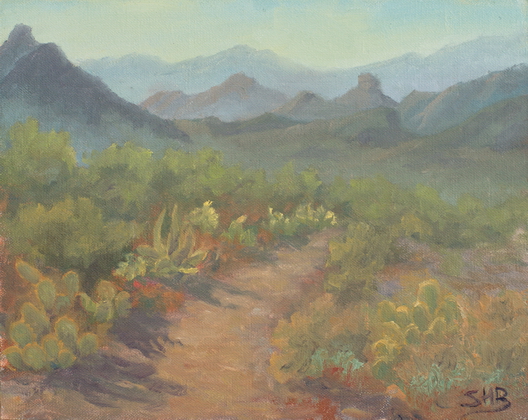More than two dozen painters joined together at the Sarasota Trailhead in Tucson Mountain Park this morning, where TPAPS signature member Jack Wahl a did a short presentation. Rather than just doing a demo painting, he talked about the field study he made at the site the day before, and shared a wealth of painting tips with the group. He also illuminated one of my current artistic struggles.
“There are two reasons for painting en plein air,” Jack said. “One is for info to take back to your studio, and the second is to complete a finished work. Today, I think too many people try to finish all their plein air paintings—and I don’t always think that’s a good thing.” This seems to be a recurring theme I hear as I talk to artists around the country. Increasing knowledge of—and general interest in—plein air painting has many artists discussing the relative benefits of painting outdoors versus in the studio.
California artist Kathleen Dunphy wrote two interesting blogs titled Why Plein Air? and Plein Air vs. Studio:Finding the Balance. She states, “No painting done from a photo can ever compare to the energy, immediacy, and sense of place that can come through in a plein air piece. Somehow the feel of the day, be it heat or cold or wind or just a perfectly pleasant morning, makes its way down the arm and off the brush and onto the canvas. I wish I knew how it happens so I could fake that quality in the studio, but that’s the magic of plein air.“
My current 2013 Plein Air Odyssey forces on-location painting because our RV is a bit small for studio work—unless a picnic table under the awning counts! I really comprehend Kathleen’s “requirement” for painting outdoors, and I’ll never forget the hummingbird that kept returning to hover over my red paints while I worked at the front of our RV a few weeks ago!
I am reminded of Marc Hansen’s recent blog, Painting Around My New Home, in which he states, “In painting the landscape, in my opinion, you must become intimately familiar with the mood of the land, the smells, sounds, climate affects, the weather patterns, the way the sky above changes the look of the dirt, trees, rocks, and water. You must sense what the land is about every single time you head out to paint.”
So, this has become a major part of my quest. How do I become intimately familiar with a place, when my time at any spot is limited? Will I be able to hone my observation skills and memory to not only grasp the reality of a specific time, but to reflect the essence of the space in my paintings? Will this body of work be mostly field studies and flingers (those paintings so poorly done that my desire is to immediately fling them from the easel) with only a few occasional gems?
Photos and journal notes are excellent ways to enhance my memory of a painting spot, but I still wonder if that will be enough to transform some of these field studies when I return to my studio in September. Such diverse landscapes await me! From desert plains to coastal cliffs, inlet waters to northern rain forests, mountains covered with disease-infested pines to towering white glaciers, saguaro-filled canyons with hidden cactus blooms to vast Alaskan vistas dotted with lush wild flowers, towering redwood forests to farm lands, clear blue Arizona skies to cloudy Oregon mists, small Inside Passage communities to major metropolises along the way, this trip incorporates them all. Whew! What a beautiful, exciting and intimidating odyssey this will be!

